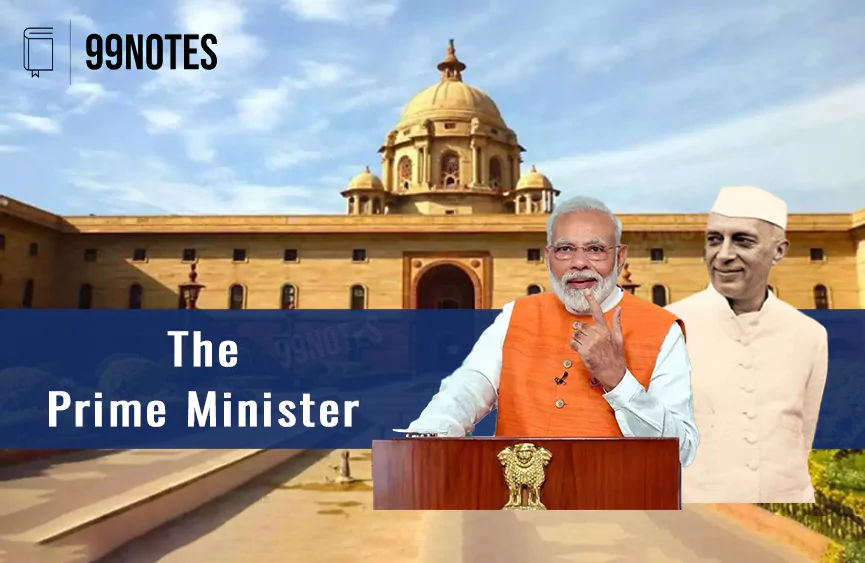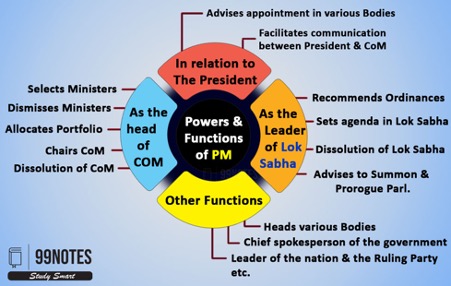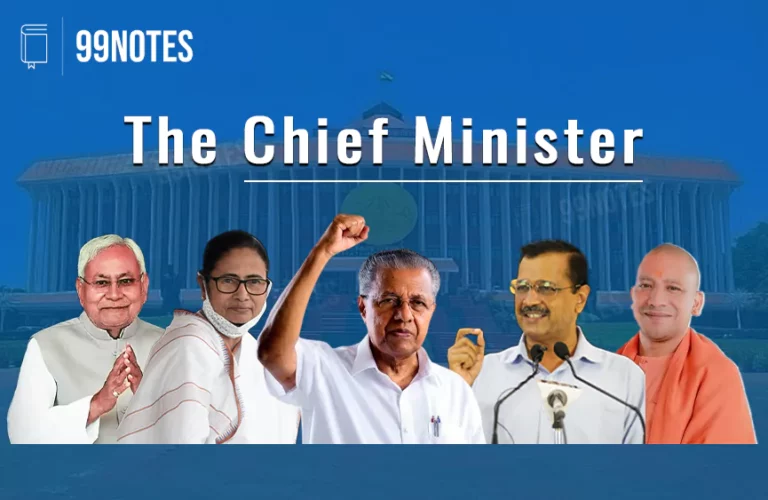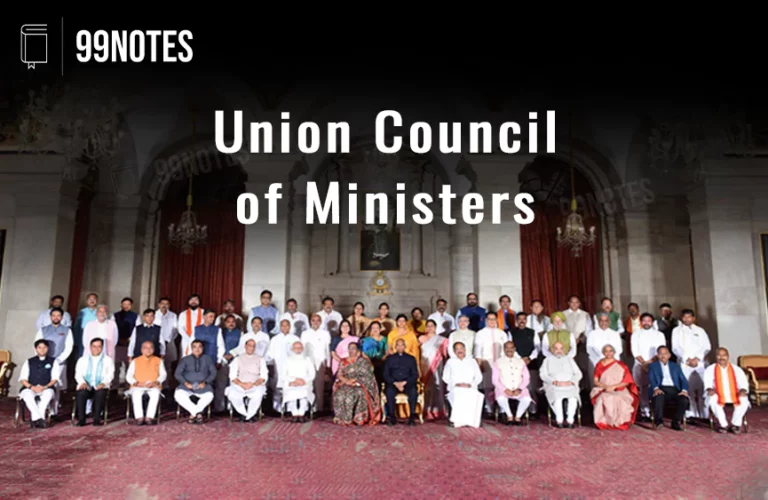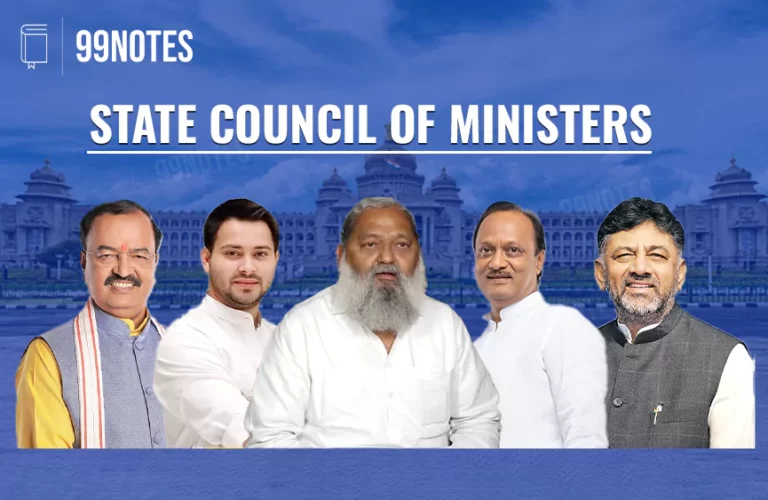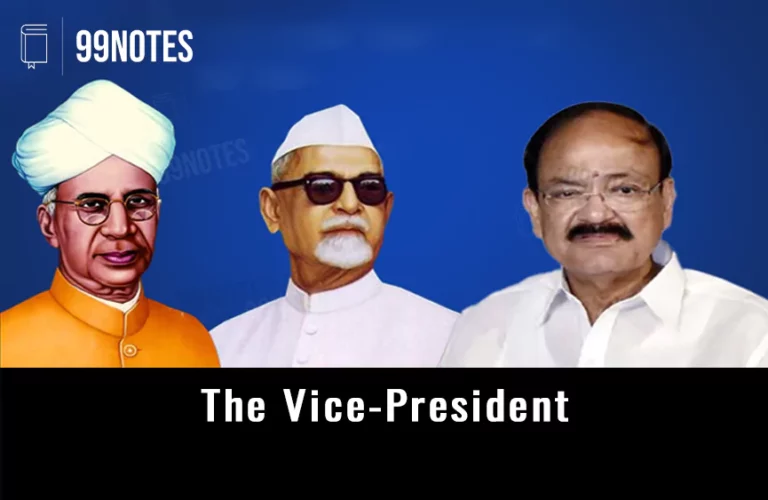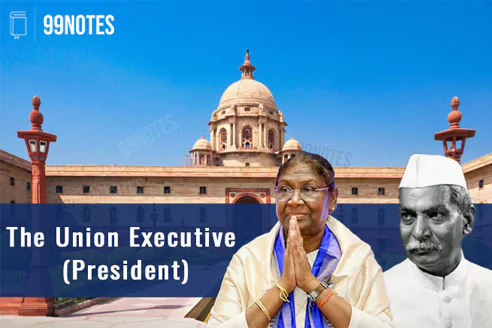Prime Minister of India and PMO- UPSC Notes
Prime Minister of India (PM)
Article 74 of the Constitution provides that “there shall be a Council of Ministers with the Prime Minister at the head to aid and advise the President who shall, in the exercise of his functions, act in accordance with such advice”.
Thus, the real executive power vests in the Union Council of Ministers (CoM), which is headed by the Prime Minister. Hence, it is clear that the President is the Constitutional head of state, but the real head of the government is the Prime Minister.
Appointment of the Prime Minister (PM)
- The Prime Minister is appointed by the President;
- However, the President does not exercise his choice in the selection of the Prime Minister; as per the Parliamentary conventions, s/he has to invite the leader of the majority party to form the government.
- However, there are some situational discretions available to the President in certain cases, such as:
-
- When no party has a clear majority, in such cases, the President invites the person who is likely to command the support of a coalition of parties that make up the majority in the Lok Sabha. For instance, after the fall of the Janata government, the then President Neelam Sanjiv Reddy appointed Charan Singh (the then leader of a coalition) as the Prime Minister.
- When the Prime Minister dies during his term, and there is no obvious successor. For instance, after Indira Gandhi’s assassination, then President Gyani Zail Singh appointed Rajiv Gandhi as the Prime Minister, ignoring the convention of appointing a caretaker Prime Minister.
- Judicial Rulings regarding the appointment of the Prime Minister:
-
- In 1980, the Delhi High Court ruled that the Constitution does not require a person to prove his/her majority before being appointed as the Prime Minister.
- In 1997, the Supreme Court ruled that a person who is not a Member of Parliament (MP) can be appointed as the Prime Minister for six months, within which s/he must be elected/nominated to either house of Parliament.
Should a Rajya Sabha member be appointed as the Prime Minister? |
i. Jawahar Lal Nehru had asked all the cabinet members from the Rajya Sabha that they must contest elections if they wanted to continue as cabinet ministers after the general election. ii. After Prime Minister Indira Gandhi was elected from the Rajya Sabha, HV Kamath, a former member of the Constituent Assembly and then Member of Parliament, brought a private member’s bill to amend the Articles 75 and 164 of the Constitution to include that the Council of ministers at both union level and state level should consist of members directly elected by the people and the Prime Minister (PM) and the Chief Minister (CM) should in no circumstance be a member who has been elected indirectly. He gave the following arguments:
iii. In response to the bill, the Congress government stated that the government and the party both were in principle agreement with the view that the Prime Minister should be a member elected to the Loksabha; however, it should not be included in the Constitution but rather developed as a healthy convention. However, in defence, it can be said that the Constitution does not envisage a Presidential system where the head of government is directly elected. In India, people choose their representatives, who in turn choose the government. Further, this allows various domain experts, who cannot handle the rough and tumble of political life, to participate in the government. For example, Dr Manmohan Singh. |
Oath, Term and Remuneration of Prime Minister
- Oath: The Prime Minister is required to take the oath of office and secrecy before the President of India before entering the office. The oath of office and secrecy of the Prime Minister is mentioned in the 3rd Schedule of the Indian Constitution.

- Term: The Constitution does not mention any term for the office of Prime Minister. The Prime Minister holds office as long as s/he enjoys a majority in the Lok Sabha. If s/he loses the confidence of the Lok Sabha, s/he must resign, or the President can dismiss him/her.
- Remuneration: The remunerations of the PM are determined by the Parliament from time to time. S/he gets the remunerations that are payable to a Member of Parliament; in addition, s/he is entitled to sumptuary allowances, medical facilities, travelling allowances, free accommodation, etc.
- Resignation/Removal: Any minister, including the PM, can offer a resignation to the President. Ministers hold office during the ‘pleasure’ of the President. It means that ministers can also be removed by the President at any time, but only on the advice of the Council of Ministers headed by the PM.
In this article, we focus only on the Prime minister. The Council of Ministers will be taken in the next article.
Power and Function of Prime Minister of India
Though the Constitution does not specifically mention the powers and functions of the Prime Minister, in practice, s/he enjoys wide powers by virtue of being the head of the government, head of the Council of Ministers and the leader of the Lok Sabha.
The Powers and functions of the Prime Ministers can be studied under the following terms:
1. As the head of the Council of Ministers
- Recommends the name of Ministers: The President can only appoint those persons as ministers who are recommended by the Prime Ministers.
- Allocation of portfolios: The Portfolios of the ministers are allocated by the Prime Minister; s/he can reshuffle the portfolios anytime.
- Chairs the Council of Ministers: As the head of the Council of Ministers, s/he presides over the meetings of the Council and influences its decisions. In this capacity, s/he guides, controls, and coordinates the activities of all the ministers and also resolves the differences among them.
- Dismissal of the ministers: S/he can ask a minister to resign in case of a difference of opinions or can advise the President to dismiss a minister.
- Dissolution of the Council: His resignation/death leads to the automatic dissolution of the Council of Ministers.
2. As the Leader of the Lok Sabha
- Summoning and Proroguing of the Parliament: S/he can advise the President to summon and prorogue the sessions of the Parliament.
- Agenda of the Lok Sabha: The speaker of the Lok Sabha consults the Prime Minister regarding the agenda-setting of the house.
- Ordinances: The Prime Minister recommends the President to promulgate ordinances when the Parliament is out of session.
- Dissolution of the Lok Sabha: This is by far the most significant power of the Parliament; s/he can recommend the President to dissolve the Lok Sabha at any time.
3. Other Position, Power and Functions of Prime Minister
The Prime Minister heads the following Constitutional, statutory and other bodies such as:
- NITI Ayog;
- National Integration Council;
- Inter-State Council;
- National Board of Wildlife;
- National Disaster Management Authority;
- Council of Scientific and Industrial Research
- Nuclear Command Authority.
Further, the PM functions as:
- The chief spokesperson of the Union government.
- The leader of the ruling party.
- The leader of the nation.
- The head of various Cabinet Committees, such as the Appointment Committee of the Cabinet; in that capacity, s/he decides the postings of top bureaucrats, including the military chiefs.
- The head of the Nuclear Command Authority.
- Manages the political crises during emergency situations.
- Plays a significant role in the formulation of foreign policies and represents the nation in bilateral meetings and in multilateral institutions like the United Nations, G20, NAM, SAARC, etc.
Prime Minister relation with the President of India
- Facilitates communication between the President and the Council of Ministers. [Article 78] The Prime Minister is duty-bound to do the following:
-
- To convey to the President all decisions of the Council of Ministers pertaining to the administration of the union affairs and legislative proposals.
- to provide such information relating to the administration of Union affairs and legislative proposals that the President may call for;
- if the President so requires to submit for the consideration of the Council of Ministers any matter on which a decision has been made by a minister but which has not been considered by the Council.
- The PM advises the President regarding the appointment of officials of the various Constitutional and statutory bodies, such as the Attorney General of India, Chief Election Commissioner (CEC) and other Election Commissioners, Comptroller and Auditor General of India (CAG), Chairperson and Members of the Union Public Service Commission, Chief Information Commissioner and Information Commissioners, Chairperson and members of the Finance Commission.
Relationship between the Prime Minister and the President
|
The following Constitutional provisions deal with the relationship between the Prime Minister and the President.
1. To convey to the President all decisions of the Council of Ministers pertaining to the administration of the union affairs and legislative proposals. 2. to provide such information relating to the administration of Union affairs and legislative proposals that the President may call for; 3. if the President so requires to submit for the consideration of the Council of Ministers (CoM) any matter on which a decision has been made by a minister but which has not been considered by the Council. |
Position of the Prime Minister
In a Parliamentary system, the Prime Minster wields a wide range of Powers. Describing the position of India, Dr BR Ambedkar stated, “If any functionary under our constitution is to be compared with the President of the USA, he is the Prime Minister and not the president of India”.
- Variables shaping the Position: However, the position of the Prime Minister is not shaped by just the Constitutional provisions and conventions only; other variables such as the nature of the party system, political culture and personality of the Prime Minister also play an important role.
- Position w.r.t to the Council of Ministers: The Prime Minister’s position with respect to the Council of Ministers can be described in two ways:
-
- Primus Inter Pares (First among equals)
- Luna Inter Stellas Minores (Moon among stars)
Depending on the political culture in the party, the personality of the leader and the numerical strength of the primary ruling party, the position varies.
- The position of Prime Minister in the Parliamentary system has been described by Constitutional commentators and scholars in the following ways:
-
- Lord Morley: “Keystone of the Cabinet arch”.
- Ivor Jennings: “He is rather a Sun, around which planets revolve. He is the keystone of the Constitution. All roads in the Constitution lead to the Prime Minister”.
- Harold J Laski: Describing the relationship between the Prime Minister and the Cabinet, he stated, “The Prime Minister is central to its life and central to its death”.
- Munro: “Captain of the ship of state”.
The Prime Minister’s Office (PMO)
It is an extraconstitutional body that provides secretarial assistance to the Prime Minister. It is a ‘department’ under the Government of India Allocation of Business Rules, 1961. It is considered the most important centre of power in the country.
Evolution of PMO
- Under Nehru, the ‘Prime Minister’s Secretariat’ was established as the personal secretariat to the Prime Minister.
- Under Lal Bahadur Shastri, the Administrative Reform Commission (1964), chaired by Morarji Desai, suggested strengthening the institution in the wake of the ever-increasing workload of the Prime Minister. Hence, the Prime Minister’s Office, in its current structure, came into existence.
- Under the Prime Ministership of Morarji Desai, the nomenclature was changed from ‘Prime Minister’s Secretariat’ to the ‘Prime Minister’s Office (PMO) in 1977. This was done to tone down the over-centralisation of power by the PMO during the Emergency.
Structure of PMO
- The PMO is headed politically by the Prime Minister and administratively by the Principal Secretary; conventionally, s/he is a serving or retired civil servant.
- Additionally, it consists of the National Security Advisor, 1 or 2 Additional Secretaries to the PM, 3 to 5 Joint Secretaries to the PM and a number of Directors, Deputy Secretaries and Under Secretaries.
Functions of PMO
- The office acts as a link between the Prime Minister and the ministers, President, Governors, Chief Ministers and foreign representatives.
- It assists the Prime Minister in his/her discharge of duties as the chief executive.
- Assists the Prime Minister in his/her discharge of duties as the head of the NITI Ayog.
- To deal with the public relations side of the Prime Minister, like interaction with the press, media and general public.
- The office deals with all the references, which, under the rules of business, have to come to the PM.
- The strategic departments of the Government of India, like the Department of Space, Department of Atomic Energy, and Research and Analysis Wing (RAW), directly come under the PMO.
- The office handles the Prime Minister Relief Fund (PMNRF), National Defence Fund and PM Cares Fund.
- The office acts as the think tank of the government.
Criticism of the Institution of PMO
- Scope of misuse of power: The institution is not bound by any defined rules; hence, it can go beyond its functioning (As during the Emergency).
- Undermines Executive: The PMO is criticised for undermining the Cabinet Secretary and Secretariat.
- Parallel Government: It is criticised for functioning as a parallel executive body and diminishing the role of the Council of Ministers by ignoring collective decision-making.
- No Checks and Balances: Since it is the most powerful office, there are no mechanisms of checks and balances.
Other Related Links:
| President of India | Vice President |
| Union Council of Ministers | The Governor |
| Chief Minister | State Council of Ministers |
FAQ’s Related to Prime Minister
Who was the First Prime Minister of India ?
Jawaharlal Nehru was the First Prime Minister of India.
Who was the 2nd Prime Minister of India ?
Shri Gulzarilal Nanda was the Second Prime Minister of India.
List of Prime Minister of India.
Here is a list of Prime Ministers of India:
- Jawaharlal Nehru (1947-1964)
- Gulzarilal Nanda (Acting, 1964)
- Lal Bahadur Shastri (1964-1966)
- Gulzarilal Nanda (Acting, 1966)
- Indira Gandhi (1966-1977)
- Morarji Desai (1977-1979)
- Charan Singh (1979-1980)
- Indira Gandhi (1980-1984)
- Rajiv Gandhi (1984-1989)
- Vishwanath Pratap Singh (1989-1990)
- Chandra Shekhar (1990-1991)
- V. Narasimha Rao (1991-1996)
- Atal Bihari Vajpayee (1996)
- D. Deve Gowda (1996-1997)
- Gujral (1997-1998)
- Atal Bihari Vajpayee (1998-2004)
- Manmohan Singh (2004-2014)
- Narendra Modi (2014-present)
What is the age limit for Prime Minister?
There is no specific age limit defined in the Indian Constitution for the position of Prime Minister. Also there is no limit on the number of times a person can become the Prime Minister of India as per the Indian Constitution. As long as an Individual meets the eligibility criteria and have the support of the majority in the Lok Sabha, S/He can serve as Prime Minister multiple times, with each term determined by the outcome of general elections.
The Prime Minister of India takes his oath of office and secrecy before the President of India.

